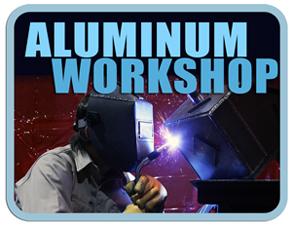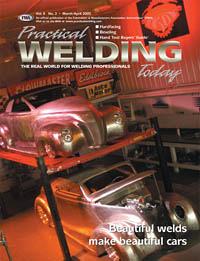President
- FMA
- The Fabricator
- FABTECH
- Canadian Metalworking
Categories
- Additive Manufacturing
- Aluminum Welding
- Arc Welding
- Assembly and Joining
- Automation and Robotics
- Bending and Forming
- Consumables
- Cutting and Weld Prep
- Electric Vehicles
- En Español
- Finishing
- Hydroforming
- Laser Cutting
- Laser Welding
- Machining
- Manufacturing Software
- Materials Handling
- Metals/Materials
- Oxyfuel Cutting
- Plasma Cutting
- Power Tools
- Punching and Other Holemaking
- Roll Forming
- Safety
- Sawing
- Shearing
- Shop Management
- Testing and Measuring
- Tube and Pipe Fabrication
- Tube and Pipe Production
- Waterjet Cutting
Industry Directory
Webcasts
Podcasts
FAB 40
Advertise
Subscribe
Account Login
Search
Aluminum Workshop: Arc welding aluminum with other processes
- By Frank Armao
- Updated January 25, 2023
- December 26, 2014
- Article
- Aluminum Welding

We answer subscriber questions about arc welding aluminum including processes like SMAW, FCAW, GMAW, and stick welding aluminum
Q: Columnist’s Note: This issue’s column addresses several questions subscribers have asked about shielded metal arc welding (SMAW) of aluminum. Some of you asked about a flux cored welding (FCAW) wire for aluminum and where to get it. Others asked whether aluminum has ever been submerged arc welded (SAW). In addition, one subscriber asked why I answer only gas tungsten arc welding (GTAW) and gas metal arc welding (GMAW) questions. The following is my attempt to cover all of these questions.
A: Before I begin, let me say that while I have answered questions in the past primarily about GTAW and GMAW, please don’t feel the need to restrict your questions to these areas. If you have questions about laser welding or friction stir welding, for example, please ask. I’ll be happy to try to answer them here.
Shielded Metal Arc Welding
SMAW was an important aluminum fabrication process in the past, but as GTAW and GMAW have evolved, it has lost much of its commercial importance. Most companies that supply welding consumables provide aluminum SMAW electrodes. However, you rarely see aluminum SMAW commercially today, although home hobbyist welders and small fabricators still commonly use it.
First, you should realize that aluminum is an active metal that has a strong tendency to combine with oxygen to form aluminum oxide. Therefore, it’s more difficult to protect aluminum with a flux than less reactive materials, such as iron. Second, to make a good flux for aluminum, the materials used must be more chemically active than aluminum. This rules out almost all of the flux materials used on steel SMAW electrodes.
So it’s difficult to make an effective flux for aluminum SMAW electrodes. It was done many years ago, but the fluxes that were developed then have several potential drawbacks. First, they aren’t 100 percent effective, so most aluminum shielded metal arc welds suffer from a large amount of porosity. Second, they are very hygroscopic, so they require good storage practices so they don’t absorb water vapor from the air. Third, the solidified flux is corrosive to aluminum and other materials. If it isn’t completely removed from the weld after welding, it can cause corrosion in a short period of time. Fourth, the flux is corrosive and environmentally unfriendly. Last, while aluminum is chemically active, magnesium is even more active, which makes it difficult to shield aluminum/magnesium filler alloys with a flux. In fact, the only available aluminum SMAW electrodes are of the 4043 type.
In light of these limitations, it isn’t surprising that once welders started using GTAW and GMAW for aluminum, the use of SMAW gradually declined. Why would anyone use it today, you ask? It does have an advantage over GTAW and GMAW: The equipment needed is significantly cheaper than that used for GTAW or GMAW. All that you need is an inexpensive DC SMAW power supply—no gas bottles, torches, regulators, or other related equipment. Having said that, you can understand why home hobbyist welders primarily use SMAW for aluminum.
I honestly can’t think of an application for which I would recommend SMAW over GTAW or GMAW. I especially don’t recommend it for welding thin aluminum because it’s very difficult to control and very easy to burn through.
Submerged Arc Welding
People often ask me, “When is somebody going to invent a flux and wire combination for submerged arc welding aluminum?” Well, the fact is that such fluxes were invented about 30 years ago. The problem is that they suffer from the same problems as SMAW. SAW of aluminum has remained a laboratory curiosity and has never been commercialized. I don’t see it happening in the near future either.
Flux Cored Arc Welding
By now you’ve probably figured out that all of these problems apply to FCAW as well. In addition, getting enough flux inside a small-diameter wire is a challenge. It works for steel, but aluminum requires more flux for a given volume of aluminum sheath than steel does. So my answer is that no FCAW wire, that I know of, exists for aluminum.
Oxyfuel Welding
But let’s not end on a negative note. The welding process that actually works well on aluminum, and especially thin aluminum, is oxyfuel welding. You don’t hear much about OFW anymore, although it once was used widely.
One school of thought says you shouldn’t use acetylene as a fuel gas on aluminum because the flame contains carbon, which leaves sooty deposits behind and makes it hard to see while welding. I’ve never had a problem using acetylene, but if you do, I recommend using hydrogen as a fuel gas. It contains no carbon, but makes an effective fuel gas. The only real disadvantage to OFW of aluminum is that it is slow. This has resulted in its demise in most industries, but shouldn’t be much of a deterrent to the home hobbyist who wants to repair a boat, for example.
The one place I still see heavy use of aluminum OFW is in automobile restoration. In this application, the process is slow enough that a really skilled welder can make the metal move in the desired direction and get much less distortion than it possible with just about any other welding process. Plus, an oxyfuel welding system is no more expensive than that DC SMAW power supply you were looking at.
About the Author

Frank Armao
Aluminum Consulting Inc.
440-479-0239
About the Publication
Related Companies
subscribe now

The Welder, formerly known as Practical Welding Today, is a showcase of the real people who make the products we use and work with every day. This magazine has served the welding community in North America well for more than 20 years.
start your free subscription- Stay connected from anywhere

Easily access valuable industry resources now with full access to the digital edition of The Fabricator.

Easily access valuable industry resources now with full access to the digital edition of The Welder.

Easily access valuable industry resources now with full access to the digital edition of The Tube and Pipe Journal.
- Podcasting
- Podcast:
- The Fabricator Podcast
- Published:
- 04/16/2024
- Running Time:
- 63:29
In this episode of The Fabricator Podcast, Caleb Chamberlain, co-founder and CEO of OSH Cut, discusses his company’s...
- Trending Articles
Sheffield Forgemasters makes global leap in welding technology

Welding student from Utah to represent the U.S. at WorldSkills 2024

Lincoln Electric announces executive appointments

Engine-driven welding machines include integrated air compressors

ESAB unveils Texas facility renovation

- Industry Events
16th Annual Safety Conference
- April 30 - May 1, 2024
- Elgin,
Pipe and Tube Conference
- May 21 - 22, 2024
- Omaha, NE
World-Class Roll Forming Workshop
- June 5 - 6, 2024
- Louisville, KY
Advanced Laser Application Workshop
- June 25 - 27, 2024
- Novi, MI


























